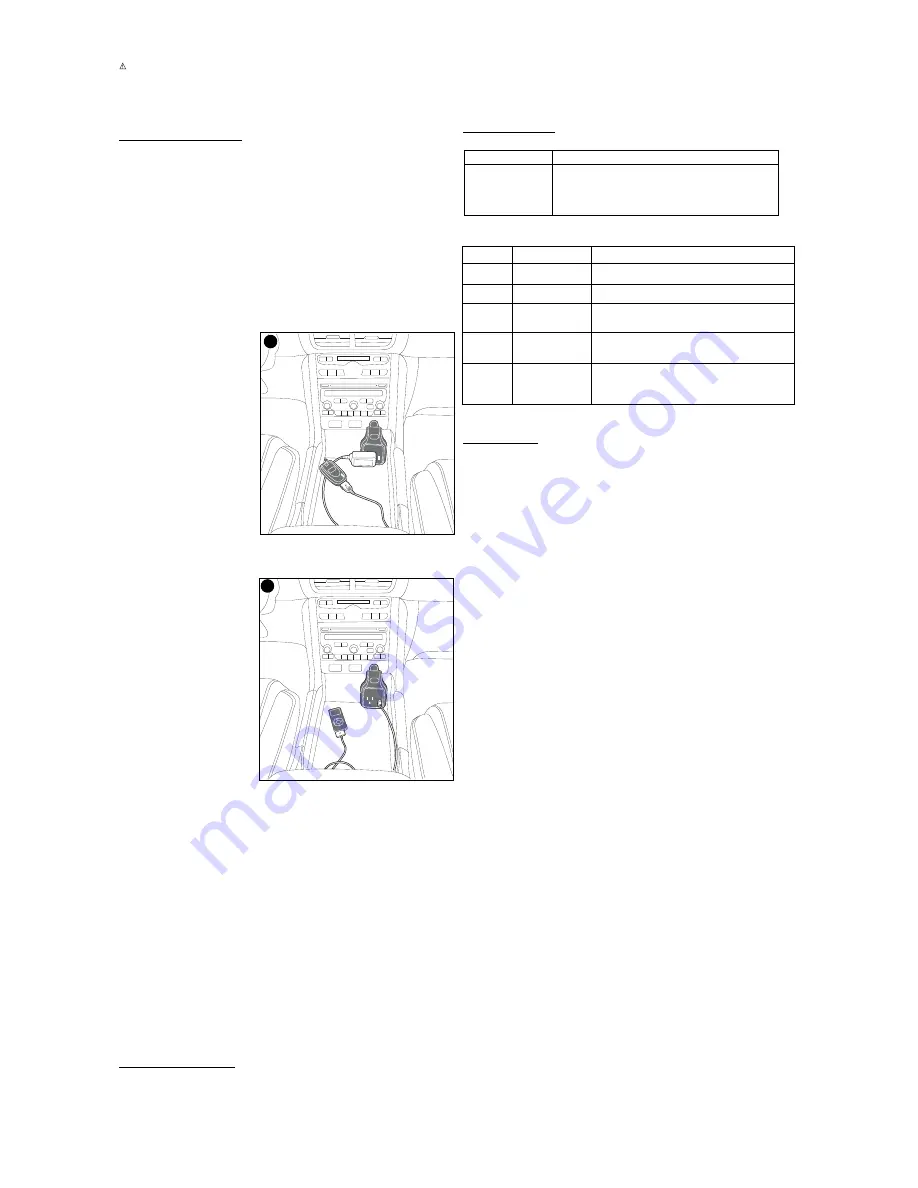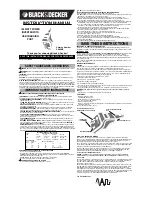
CAUTION — RECHARGEABLE DEVICES
• Certain rechargeable devices are designed to be charged by plugging them directly into an AC recep-
tacle. These devices may damage the inverter or the charging circuit.
• If there is any sign that your appliance is behaving differently to that when connected to the normal
power source then unplug and seek advice from your appliance manufacturer.
• This problem does not occur with most of the battery-operated equipment. Most of these devices use a
separate charger or transformer that is plugged into an AC receptacle.
• The inverter is capable of running most chargers and transformers.
OPERATING INSTRUCTIONS
The Power/Fault LED Indicator lights green when the inverter is properly connected to a functioning DC
power source. The AC and USB outlets are ready to use. (If the Power/Fault LED Indicator lights red,
refer to the Troubleshooting Section of this Instruction Manual.)
To turn the unit off, disconnect it from the 12 volt DC power source.
Always connect the inverter to the 12 volt DC power source before plugging any devices into the unit.
The standard North American 115 volt AC and USB outlets allow simultaneous operation of multiple
devices. Simply plug the equipment into the unit and operate normally.
Ensure that the wattage of all
equipment simultaneously plugged into the inverter does not exceed 100 watts continuous.
Rated Versus Actual Current Draw of Equipment
Most electrical tools, appliances, electronic devices and audio/visual equipment have labels that indicate
the power consumption in amps or watts. Be sure that the power consumption of the item to be operat-
ed is below 100 watts. If the power consumption is rated in amps AC, simply multiply by the AC volts
(115) to determine the wattage.
Resistive loads are the easiest for the inverter to run; however, it will not run larger resistive loads (such
as electric stoves and heaters), which require far more wattage than the inverter can deliver. Inductive
loads (such as TVs and stereos) require more current to operate than do resistive loads of the same
wattage rating.
For safety reasons, the unit will simply shut down if it is overloaded. To restart the unit, simply remove
the load, wait a few minutes, then plug it back in, rotating slightly to make sure there is good contact.
Operation of the 115 Volt AC Outlet - Figure A
1. Connect the unit to a vehicleʼs
accessory outlet or other 12 volt DC
power source. Make sure there is
adequate space for proper ventilation
of the inverter (figure A).
2. Rotate the unit slightly to make sure
there is good contact.
3. The Power/Fault LED Indicator will light
green, indicating a proper connection. If
the Power/Fault LED Indicator lights
red, a Fault condition exists. Refer to
the Troubleshooting Section of this
Instruction Manual.
4. If the inverter does not work, make sure
the ignition/accessory outlet is powering
the accessory outlet. Some vehicles
require the ignition switch to be turned
on.
5. Plug the (110/120 volt AC) appliance
into the inverterʼs three-prong AC outlet
and operate normally (figure A).
Notes:
The inverter will not operate
appliances and equipment that
generate heat, such as hair
dryers, electric blankets, microwave
ovens and toasters.
Remember to disconnect the unit from any power source when it is not in use.
Operation of the USB Charging Port - Figure B
1. Connect the unit to a vehicleʼs accessory outlet or other 12 volt DC power source. Make sure there
is adequate space for proper ventilation
of the inverter (figure B).
2. Rotate the unit slightly to make sure
there is good contact.
3. The Power/Fault LED Indicator will light
green, indicating a proper connection. If
the Power/Fault LED Indicator lights
red, a Fault condition exists. Refer to
the Troubleshooting Section of this
Instruction Manual.
4. If the inverter does not work, make sure
the ignition/accessory outlet is powering
the accessory outlet. Some vehicles
require the ignition switch to be turned
on.
5. Plug the USB-powered device into the
inverterʼs USB Charging Port and oper-
ate normally (figure B).
Note:
This inverterʼs USB Charging Port
does not support data
communication. It only provides
5 volts DC/500 mA power to an
external USB-powered device.
Note:
Not all mobile phones are provided
with a charging cable, they are
normally data cables which are not supported by this device - please check with your mobile
phone manufacturer for the correct charging cable. Remember to disconnect the unit from any
power source when it is not in use.
Protective Features
The inverter monitors the following conditions:
Low Battery Voltage —
This condition is not harmful to the inverter, but could damage the power
source, so the inverter will automatically shut down when input voltage drops below 10.5 ± 0.3 volts DC.
Once the voltage recovers the inverter will auto restart.
Input Voltage Too High —
The inverter will automatically shut down when DC input voltage exceeds
15.5 ± 0.3 volts, as this can harm the unit. Once the voltage recovers the inverter will auto restart.
Thermal Shutdown Protection —
The inverter will automatically shut down when the unit becomes
overheated.
Overload/Short Circuit Protection —
The inverter will automatically shut down when a short circuit
occurs.
Notes:
The Power/Fault LED Indicator will light red to indicate a Fault condition before automatic
shutdown occurs.
If unit shuts down, disconnect it from the 12 volt DC power source, remove the load, wait a few
minutes, then plug it back in, rotating slightly to make sure there is good contact.
Operating Tips
The inverter should only be operated in locations that are:
DRY — Do not allow water or other liquids to come into contact with the inverter.
COOL — Surrounding air temperature should ideally be 10-20°C (50-68°F). Keep the inverter away from
direct sunlight, when possible.
WELL-VENTILATED — Keep the area surrounding the inverter clear to ensure free air circulation
around the unit. Do not place items on or over the inverter during operation. The unit will shut down if
the internal temperature gets too hot. The inverter will auto-reset after it cools down.
SAFE — Do not use the inverter near flammable materials or in any locations that may accumulate
flammable fumes or gases. This is an electrical appliance that can briefly spark when electrical
connections are made or broken.
CARE AND MAINTENANCE
Storage
1. Ideal storage temperature range is 0-40°C (32-104°F).
2. Store and use the inverter in a cool, dry place with adequate ventilation for all-around air circulation.
3. Avoid locations that are exposed to heating units, radiators, direct sunlight, or excessive humidity or
dampness.
A
B
LED Color
Possible Cause
Recommendation
Flashing
Amber
Low input voltage
Start Engine
Red
Battery voltage below
10.5 volts
Recharge battery or check DC power supply.
Red
Equipment being
operated draws too
much power
Reduce load to maximum 100 watts.
Red
Inverter in thermal
shutdown condition
Allow inverter to cool down. Ensure there is adequate
ventilation around the load is no more than 100 watts for
continuous operation.
Red
AC output is shorted
Unplug the AC appliance. Disconnect the unit from any 12 volt
DC power source. Check the appliance cord. Refer to the
Service Information section that follows to contact a
Black & Decker Service Center.
Problem
Explanation/Recommendation
Buzzing sound in audio
systems
Some inexpensive stereo systems and boom boxes make a buzzing
sound when operated from the inverter, because the power supply in
the electronic device does not properly filter the modified sine wave
produced by the
inverter. The only solution to this problem is to use a sound system
that has a higher quality power supply.
Power/Fault LED Indicator
The Power / Fault LED Indicator has 3 states ;
Green - normal operation.
Flashing amber - low input voltage, AC output still on.
Red - Fault condition, AC output switched off. See the Protective Features Section of this Instruction
Manual and Fault Conditions in the following section.
TROUBLESHOOTING
Common Audio Problems
Fault Conditions
SPECIFICATIONS
Output Power:
100 watts continuous
DC Input:
13.8 volts DC, 8 amps
AC Output:
100 watt continuous output – 115V AC @13.8V DC, 60 Hz
USB Charging Port Output:
5 volts DC/500 mA
Fuse:
10 amp internal fuse
Output Waveform:
Modified Sine Wave
Optimum Efficiency:
>85%
Low Voltage Shutdown:
<10.5 ± 0.3 volts input voltage
Operating Temperature:
10-20°C (50-68°F)
Storage Temperature:
0-40°C (32-104°F)
Operating/Relative Humidity:
5-95% non-condensing




















